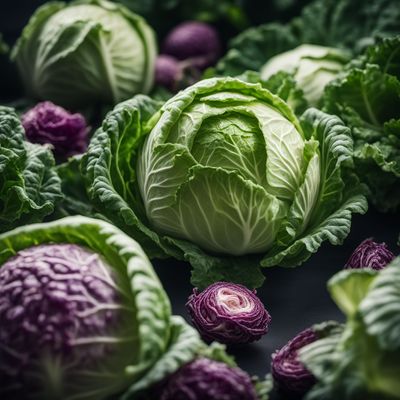
Ingredient
Other head brassica (p)
The Versatile Brassica: Unleashing the Potential of Other Head Brassica
Other head brassica is characterized by its dense and compact head, which is composed of tightly packed leaves. It has a crisp and crunchy texture, similar to cabbage, and a slightly bitter and peppery taste. The appearance of other head brassica can vary depending on the specific variety, ranging from pale green to deep purple.
Origins and history
Other head brassica has a long history dating back to ancient times. It is believed to have originated in the Mediterranean region and was cultivated by the Greeks and Romans. Over time, different varieties of other head brassica were developed, including broccoli, cauliflower, Brussels sprouts, and kale. Today, other head brassica is grown and consumed worldwide, with each variety offering its unique flavor and culinary applications.
Nutritional information
Other head brassica is a nutrient-dense ingredient, rich in vitamins C, K, and A, as well as dietary fiber and antioxidants. It is also low in calories and fat, making it a healthy addition to various dishes.
Allergens
There are no known allergens associated with other head brassica.
How to select
When selecting other head brassica, look for heads that are firm, compact, and free from any signs of wilting or discoloration. The leaves should be vibrant and crisp, without any yellowing or browning. Avoid heads with soft spots or signs of insect damage. For the best flavor and texture, choose smaller heads, as they tend to be more tender and flavorful.
Storage recommendations
To maintain the freshness of other head brassica, store it in the refrigerator in a plastic bag or airtight container. It can stay fresh for up to a week, but it is best to consume it as soon as possible for optimal taste and texture. Avoid washing or cutting the heads until ready to use, as this can accelerate spoilage.
How to produce
Other head brassica can be grown in home gardens or containers with proper care and attention. It requires well-draining soil, ample sunlight, and regular watering. Start by planting seeds or seedlings in early spring or fall, depending on the specific variety. Provide adequate space for the plants to grow and develop, and protect them from pests and diseases.
Preparation tips
Other head brassica can be prepared in various ways, depending on the specific variety. It can be steamed, boiled, roasted, stir-fried, or eaten raw in salads and slaws. To enhance its flavor, season other head brassica with herbs, spices, or dressings. It pairs well with ingredients like garlic, lemon, olive oil, and Parmesan cheese. Experiment with different cooking techniques and flavor combinations to discover your favorite preparation method.
Culinary uses
Other head brassica is a versatile ingredient that can be used in a wide range of dishes. It is commonly used in stir-fries, soups, stews, casseroles, and salads. It can also be roasted or grilled as a side dish or added to pasta dishes and grain bowls for added texture and flavor. Other head brassica is a popular choice for vegans and vegetarians, as it can be used as a meat substitute in dishes like cauliflower steaks or broccoli burgers.
Availability
Other head brassica is commonly available in grocery stores, supermarkets, and farmers markets worldwide. It is cultivated in many countries, including the United States, Canada, Mexico, China, and European countries like Italy and France.



